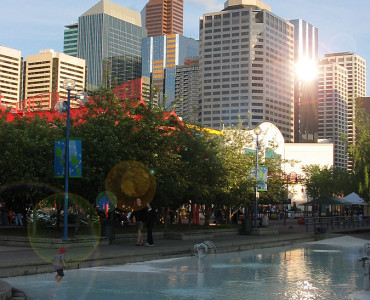Homestay in Calgary – Alberta – Canada

City Overview


Downtown features an eclectic mix of restaurants and bars, cultural venues, public squares (including Olympic Plaza) and shopping. Notable shopping areas include such as The Core Shopping Centre (formerly Calgary Eaton Centre/TD Square), Stephen Avenue and Eau Claire Market. Downtown tourist attractions include the Calgary Zoo, the Telus Spark, the Telus Convention Centre, the Chinatown district, the Glenbow Museum, the Calgary Tower, the Art Gallery of Calgary (AGC), Military Museum and the EPCOR Centre for the Performing Arts. At 2.5 acres (10,000 m2), the Devonian Gardens is one of the largest urban indoor gardens in the world, and it is located on the 4th floor of The Core Shopping Centre (above the shopping). The downtown region is also home to Prince’s Island Park, an urban park located just north of the Eau Claire district. Directly to the south of downtown is Midtown and the Beltline. This area is quickly becoming one of the city’s densest and most active mixed use areas. At the district’s core is the popular 17 Avenue, known for its many bars and nightclubs, restaurants, and shopping venues. During the Calgary Flames’ playoff run in 2004, 17 Avenue was frequented by over 50,000 fans and supporters per game night. The concentration of red jersey-wearing fans led to the street’s playoff moniker, the “Red Mile”. Downtown is easily accessed using the city’s C-Train light rail (LRT) transit system. Attractions on the west side of the city include the Heritage Park Historical Village historical park, depicting life in pre-1914 Alberta and featuring working historic vehicles such as a steam train, paddle steamer and electric streetcar. The village itself comprises a mixture of replica buildings and historic structures relocated from southern Alberta. Other major city attractions include Canada Olympic Park, which features Canada’s Sports Hall of Fame, and Spruce Meadows. In addition to the many shopping areas in the city centre, there are a number of large suburban shopping complexes in the city. Among the largest are Chinook Centre and Southcentre Mall in the south, Westhills and Signal Hill in the southwest, South Trail Crossing and Deerfoot Meadows in the southeast, Market Mall in the northwest, Sunridge Mall in the northeast, and the newly built CrossIron Mills just north of the Calgary city limits, and south of the City of Airdrie.

Downtown can be recognized by its numerous skyscrapers. Some of these structures, such as the Calgary Tower and the Scotiabank Saddledome are unique enough to be symbols of Calgary. Office buildings tend to concentrate within the commercial core, while residential towers occur most frequently within the Downtown West End and the Beltline, south of downtown. These buildings are iconographic of the city’s booms and busts, and it is easy to recognize the various phases of development that have shaped the image of downtown. The first skyscraper building boom occurred during the late 1950s and continued through to the 1970s. After 1980, during the recession, many high-rise construction projects were immediately halted. It was not until the late 1980s and through to the early 1990s that major construction began again, initiated by the 1988 Winter Olympics and stimulated by the growing economy. In total, there are 14 office towers that are at least 150 m (490 ft) (usually around 40 floors) or higher. The tallest of these is The Bow (Encana headquarters), which is the tallest office tower in Canada outside Toronto. Calgary’s Bankers Hall Towers are also the tallest twin towers in Canada. As of 2008, there were 264 completed high-rise buildings, with 42 more under construction, another 13 approved for construction and 63 more proposed. Main article: List of tallest buildings in Calgary To connect many of the downtown office buildings, the city also boasts the world’s most extensive skyway network (elevated indoor pedestrian bridges), officially called the +15. The name derives from the fact that the bridges are usually 15 ft (4.6 m) above grade. In nearby Airdrie at the Calgary/Airdrie Airport the Airdrie Regional Airshow is held every two years. In 2011 the airshow featured the Canadian Snowbirds, a CF-18 demo and a United States Air Force F-16.

In large part due to its proximity to the Rocky Mountains, Calgary has traditionally been a popular destination for winter sports. Since hosting the 1988 Winter Olympics, the city has also been home to a number of major winter sporting facilities such as Canada Olympic Park (bobsleigh, luge, cross-country skiing, ski jumping, downhill skiing, snowboarding, and some summer sports) and the Olympic Oval (speed skating and hockey). These facilities serve as the primary training venues for a number of competitive athletes. Also, Canada Olympic Park serves as a mountain biking trail in the summer months. In the summer, the Bow River is very popular among fly-fishermen. Golfing is also an extremely popular activity for Calgarians and the region has a large number of courses. Calgary hosted the 2009 World Water Ski Championship Festival in August, at the Predator Bay Water Ski Club, approximately 40 km (25 mi) south of the city. Scotiabank Saddledome As part of the wider Battle of Alberta, the city’s sports teams enjoy a popular rivalry with their Edmonton counterparts, most notably the rivalries between the National Hockey League’s Calgary Flames and Edmonton Oilers, and the Canadian Football League’s Calgary Stampeders and Edmonton Eskimos. The city also has a large number of urban parks including Fish Creek Provincial Park, Nose Hill Park, Bowness Park, Edworthy Park, the Inglewood Bird Sanctuary, Confederation Park, and Prince’s Island Park. Nose Hill Park is the largest municipal park in Canada. Connecting these parks and most of the city’s neighbourhoods is one of the most extensive multi-use (walking, bike, rollerblading, etc.) path systems in North America. Calgary is renowned in professional wrestling tradition as both the home-city of the prominent Hart wrestling family and the location of the infamous Hart family “Dungeon”, wherein WWE Hall of Fame member and patriarch of the Hart Family, Stu Hart, trained numerous professional wrestlers including “Superstar” Billy Graham, Brian Pillman, the British Bulldogs, Edge, Christian, Greg Valentine, Chris Jericho, Jushin Thunder Liger and many more. Also among the trainees were the Hart family members themselves, including WWE Hall of Fame member and former WWE champion Bret Hart and his brother, the 1994 WWF King of the Ring, Owen Hart.
Our Programs
Homestay
Big or small, younger or older, we will tailor a program to suit your needs.
Teacher Stay
The ultimate way to learn a language and a lifestyle at the same time.
Executive Stay
Our hallmark comfort and convenience, with the addition of private bathroom.
Farm/Ranch Stay
A unique program for students interested in an alternative to the usual urban homestay.
Furnished Apartments
Convenience and comfort of a ready to live apartment.
